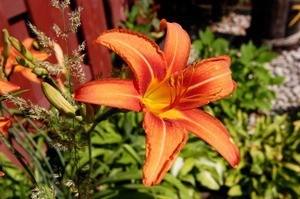 Many cultures have used edible flowers in their traditional dishes for centuries. And with a growing interest in global cuisine, edible flowers are once again coming back into vogue with the gardening masses. Whether you grow them alongside your vegetables or in containers, edible flowers are a wonderful way to bring added color, texture and flavor to your favorite summer dishes.
There are hundreds of edible flowers. Here are ten of the most common:
Many cultures have used edible flowers in their traditional dishes for centuries. And with a growing interest in global cuisine, edible flowers are once again coming back into vogue with the gardening masses. Whether you grow them alongside your vegetables or in containers, edible flowers are a wonderful way to bring added color, texture and flavor to your favorite summer dishes.
There are hundreds of edible flowers. Here are ten of the most common:
Always introduce edible flowers into your diet slowly and in small quantities to avoid digestive upsets or allergic reactions.
Avoid picking flowers from along roads and ditches, or from areas where they may have been exposed to pesticides or herbicides. Never eat flowers from nurseries, florists, or garden centers. The only way to be certain the flowers you are eating have not been exposed to chemicals is to grow them yourself, or acquire them from someone you know.
In general, people suffering from allergies, asthma, ragweed, or hay fever should avoid consuming edible flowers, especially composite flowers, as the pollen may cause extreme allergic reactions.
Here are the questions asked by community members. Read on to see the answers provided by the ThriftyFun community.
Carol from Beverly, Mass.
A resounding yes! You can absolutely eat chive blossoms! Chives are members of the Allium family, and just in case you didn't know, many members of this family (including chives, leeks, onions, and garlic) produce edible flowers.
What is so great about chive plants is their versatility in the garden. As an herb, they produce edible stems and flowers. The stems work great as an onion substitute for roasts, vegetables, salads, sandwiches, and soups. The peppery tasting flower petals make an attractive edible seasoning suitable for use in egg, cheese, and fish dishes or when kept intact and used as a garnish.
As a landscaping plant, chives produce bulbous, eye-catching purple, pink, or white blooms (depending on the variety) that sit on top of bright green tufts of decorative, grass-like stems. Chives are also good self-seeders, so if left to their own devices they will fill in a modest area of the garden quickly (under favorable conditions). Chives also exhibit some insect repelling properties, and bees love them. Once established, they aren't too fussy about their growing conditions.
Ellen
Yes, you can eat the chive flowers in salads.
Is it edible...?!!!
Why, that's like asking if the Pope's Catholic!!
Seriously, though, I put them in salads, herb butters, smoked goat cheese, sauces--you name it. They are awesome!
We started out with one plant years ago, and kept dividing it and now we have a hedge--wonderful, wonderful stuff!
The flowers are a natural part of the chive. They all flower eventually. Yes you can eat them.
Nasturtiums not only add color to your summer garden, but the flowers and young leaves taste delicious in a salad or on a sandwich. This is a page about use nasturtiums for salads and sandwiches.